A leaf is an interesting topic in class 11th biology, Unit-2 “Structural Organization in Plants and Animals”. The world around us is made of different types of plants and animals. They are all of different shapes and sizes. Most of the plants are green in colour. Leaves are one of the most important parts of a plant. They are responsible for many essential processes such as Photosynthesis, Respiration and Transpiration. As we all know plants are green because their leaves contain a green-coloured pigment which is known as Chlorophyll. This chlorophyll provides a green colour to the leaves and helps the plants make their own food.
Leaf Definition
The leaf is fattened, and lateral outgrowth of the stem or the branch develops from a node and has a bud in its axil. Leaves are usually green and are important because they make food for the plant. They grow along the stem, starting from the bottom and moving up, so older leaves are at the bottom and newer ones are at the top. Leaves grow from the plant’s outer parts, not from inside. They play a key role in helping the plant get energy from sunlight through a process called photosynthesis.
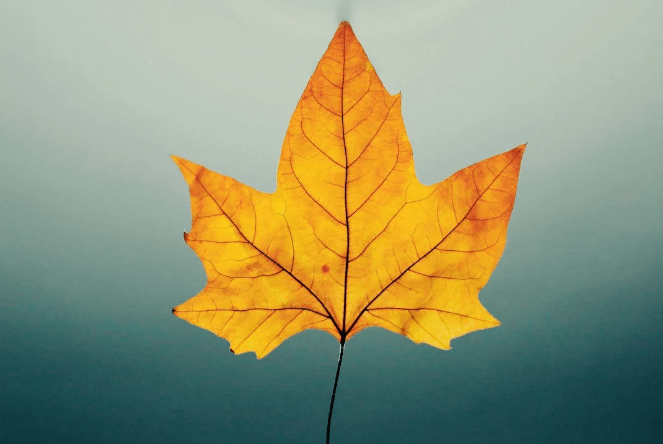
Characteristics of a Leaf
The leaves are essential plant organs that perform photosynthesis, which helps in the production of food for the plant. They typically possess flat, thin structures to maximize surface area for sunlight absorption. Leaves have a network of veins for water and nutrient transport, and they come in various shapes, sizes, and colours. The upper epidermis often contains a waxy cuticle to reduce water loss, while the lower epidermis contains tiny pores called stomata for gas exchange. Some other important characteristics of a leaf are mentioned below:
- The leaves are the lateral outgrowths of the stem or branch.
- The leaves arise at the nodes of the stem.
- The leaves are exogenous in origin and have limited growth.
- The leaves bear buds on their axial parts.
Functions of a Leaf
The leaves perform several functions in a plant including photosynthesis, transpiration, and gas exchange. However different plants might have variations in leaf functions based on their species and environmental adaptation. Here we have mentioned some more functions of a leaf:
- Photosynthesis: Leaves capture sunlight and use it to convert carbon dioxide and water into glucose and oxygen.
- Transpiration: The leaves release excess water vapour through small pores called Stomata, helping to regulate water content in the plants.
- Gas Exchange: The stomata also allow the exchange of carbon dioxide and oxygen with the atmosphere, which is very important for both respiration and photosynthesis.
- Water Transport: The leaves facilitate the movement of water and nutrients from the roots to other parts of the plant.
- Storage: The leaves can store nutrients, such as sugar and nutrients, which are used by plants for their growth and energy.
- Protection: Some of the leaves have adapted thorns or toxins to deter herbivores from consuming the plants.
- Temperature Regulation: Leaves can help regulate plant temperature by controlling water loss through transpiration.
- Phytohormones Production: Leaves produce phytohormones that regulate plants’ growth, development, and responses to environmental factors.
Parts of a Leaf and Their Functions
A leaf typically consists of several parts: Leaf base, Lamina, and Petioles. The blade (or lamina) is a flat and expanded portion. The lamina is also known as the leaf blade. The petiole, which connects the leaf to the stem, and the veins, helps in the transportation of water, nutrients, and sugar within the leaf. These all parts work together to perform photosynthesis and other essential functions in plants.
| Different Parts of a Leaf | |
| Name of the part | Description |
| Leaf Base | It is the bottom part of a leaf where it attaches to the stem or branch. It can have various shapes, such as rounded, pointed, or heart-shaped. |
| Lamina | It is the flat and typically green part of a leaf where photosynthesis takes place. |
| Petioles | It is a slender stalk that connects the leaf blade (lamina) to the stem of a flower, It provides support and allows the movement and positioning of a leaf to capture sunlight. |
1. Leaf Base
The leaf base is the bottom part of a leaf where it attaches to the stem or branch of the plant. The leaf base can have different shapes, such as rounded, pointed, or heart-shaped. The shape of the leaf base depends on the species of a plant. The leaf base provides stability and support for the leaf’s attachment to the plant and can also play a role in water and nutrient transport.
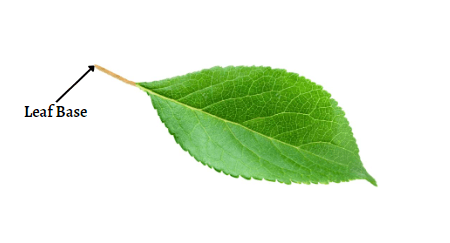
Functions of a Leaf Base
The leaf base plays a vital role in the overall health, growth, and functioning of the plant by connecting the leaves to the rest of the plant and facilitating various important processes. The leaf base also plays several other functions:
- Attachment and support: The leaf base attaches the leaf to the stem or branch, providing stability and support for the position of the leaves on the plant.
- Transport: The leaf base contains vascular tissues that help transport water, nutrients and sugar or glucose between the leaves and the rest of the plant.
- Leaf Orientation: The shape and orientation of the leaf base influence the angle at which the leaf is positioned relative to the sun, which affects its exposure to light for photosynthesis.
- Protection: The leaf can help protect the stem or branch from damage by covering the area where the leaf is attached.
- Anchoring: The leaf base aids in anchoring the leaf to the stem, especially in windy conditions, preventing the leaf from being easily dislodged.
2. Lamina
The lamina refers to the main, flat, and usually green part of the leaf. The lamina is also known as the leaf blade. It is that part of a leaf where photosynthesis takes place. The lamina contains chloroplasts, which are responsible for capturing sunlight and converting it into energy for the plant. The lamina is typically surrounded by a network of veins that provide structure and transport water, nutrients, and sugar throughout the leaf.
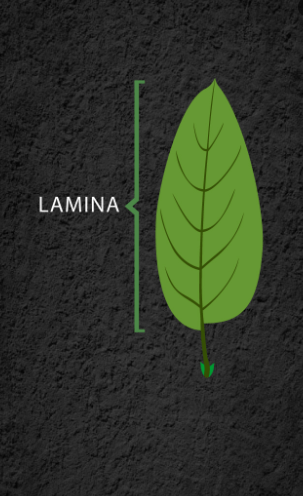
Functions of a Lamina
The lamina’s ability to perform photosynthesis and its role in gas exchange, transpiration, storage, and defence contributes to the overall health and survival of the plants.
- Photosynthesis: The primary function of the lamina is to carry out photosynthesis, the process by which plants convert sunlight, carbon dioxide and water into glucose (sugar) and carbon dioxide. This process provides energy and nutrients for the plant’s growth and development.
- Gas Exchange: The stomata, tiny pores found on the surface of the lamina, allow the exchange of gases such as oxygen and carbon dioxide with the surrounding environment. This is very essential for both photosynthesis and respiration.
- Transpiration: The lamina also plays a role in transpiration, which is the loss of water vapours from the surface of the leaf. Transpiration helps regulate the plant’s internal water balance and cools the plant through evaporation.
- Storage: Some plants store nutrients, water, or energy in the lamina, making it an important site for resource storage.
- Defence: Some plants have specialized cells or structures on the lamina that deter herbivores or protect against pathogens.
3. Petioles
The petioles of a flower are the thin stalks that connect the leaves to the stems. The petioles are similar to the stems of the leaves. But they specifically refer to the structure that supports and attaches the leaves to the plant. The petiole allows the leaf to be positioned optimally to receive sunlight and perform the process of photosynthesis.
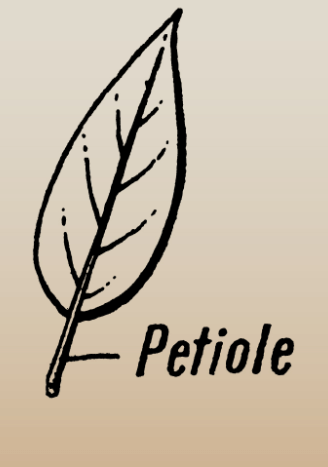
Functions of Petioles
The shape, length, and strength of the petiole can vary between different plant species, adapting to their specific needs and environment. Depending on these features the petioles have many different functions.
- Support: The petiole provides support for the leaf, holding it up and allowing it to be positioned in a way that maximizes exposure to sunlight.
- Transport: Within the petiole, there is vascular tissue that helps transport water, nutrients, and sugars between the leaf and the rest of the plant.
- Flexibility: The petiole allows the leaf to move and adjust its position in response to changing environmental conditions, such as wind or light intensity.
- Leaf Orientation: The petiole helps in the orientation of the leaf so that it can capture sunlight effectively for photosynthesis.
- Defence Mechanism: In some plants, the petiole can have defensive structures like thorns or hairs, deterring herbivores from eating the leaf.
Venation in Leaves
The arrangement or disposition of veins and veinlets in the leaf lamina is called Venation. We can simply say that leaf venation refers to the pattern of veins or vascular tissues within a leaf. These venation patterns play a role in distributing water, nutrients, and sugars throughout the leaf. They also help provide structural support to the leaf. The two main types of venation are parallel venation, where the veins run parallel to each other, and reticulate or netted, where veins form a branching network. This characteristic can help in identifying different plant species.

Types of Venation
There are mainly two types of venation in a leaf that are: Reticulate venation and Parallel venation. The specific venation type can be an important characteristic for plant identification and classification. Now let us discuss both types of venations in brief.
| Different Types of Venation | |
| Types | Description |
| Reticulate venation | In reticulate venation, the veins form a network or mesh-like pattern on the surface of the leaf. |
| Parallel venation | In parallel venation, the veins run parallel to each other along the length of the leaf. |
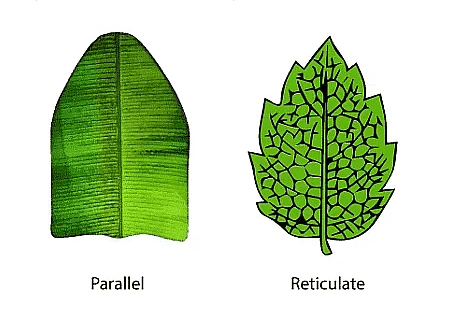
1. Reticulate Venation
The reticulate venation is a type of leaf venation pattern where veins form a network of interconnected lines resembling a net or mesh. This pattern is commonly seen in dicotyledonous plants, where the major veins diverge from a central midrib and then branch further into smaller veins, creating a network. We can also say that when veins are irregularly distributed to form a network is known as reticulate venation. The reticulate venation is of two types: Palmate and Pinnate venation.
| Different Types of Reticulate Venation | |
| Types | Description |
| Palmate Venation | Several main veins radiate outward from a single point at the base of the leaf, resembling the fingers of a hand. |
| Pinnate Venation | A single main vein, called the midrib, runs through the centre of the leaf, with smaller veins branching off. |
Pinnate Venation
In the pinnate venation, there is a single strong mid-vein (mid-rib) which gives out secondary veins on the lateral side. The lateral veins produce smaller veins and veinlets in all directions forming a network. For Examples: Peepal (Ficus religiosa) and mango (Mangifera indica) have pinnate venation.
Palmate Venation
In this type of venation, there are two or more principal veins arising from a single point and they process outwards or upwards. The two sub-types recognised in palmate venation are:
- Divergent Type: When all principal veins originate from the base and diverge from one another towards the margin of the leaf, as in Cucurbita, Carica papaya, etc.
- Convergent Type: When all principal veins instead of diverging run in a curved manner from the base to the apex of the blade, as in cinnamon (Cinnamomum) and nux-vomica, etc.
2. Parallel Venation
Parallel venation is a pattern where the veins of a leaf run roughly parallel to each other. This type of venation is often observed on monocotyledonous plants, such as grasses and lilies. In parallel venation, the veins don’t form a complex network but rather run side by side in a straight or slightly curving manner. We can simply say that when veins run parallel to each other and do not form reticulum it is known as parallel venation. Parallel venation is also of two different types: Pinnate and Palmate venation.
Pinnate Venation
There is a prominent mid-rib which gives out lateral veins perpendicularly; the latter run parallel to each other towards the margin of the lamina, as in Banana, Ginger (Zingiber), Turmeric (Curcuma), Canna, etc.
Palmate Venation
When there are two more principal veins arising from a single point and proceeding outwards or upwards, the venation is known as Palmate Venation. Palmate Venation may be Convergent or Divergent type.
- Divergent Type: All the principal veins originate from the base and diverge towards the margin of the leaf, as in fan palm (Borassus Flabellifer).
- Convergent Type: All the principal veins instead of diverging run parallel to each other from the base of the lamina and join at the apex as in bamboo.
Types of Leaves
The leaves are mainly of two different types: Simple Leaves and Compound Leaves depending upon the incision of the lamina. These classifications help botanists and students understand the diversity of plant life and how plants have evolved to suit various environments and purposes.
| Different Types of Leaves | |
| Types of Leaves | Description |
| Simple Leaves | Simple leaves are leaves with a single blade attached to the stem without any leaflet. |
| Compound Leaves | Compound leaves are leaves divided into multiple leaflets, each resembling a small individual leaf. |
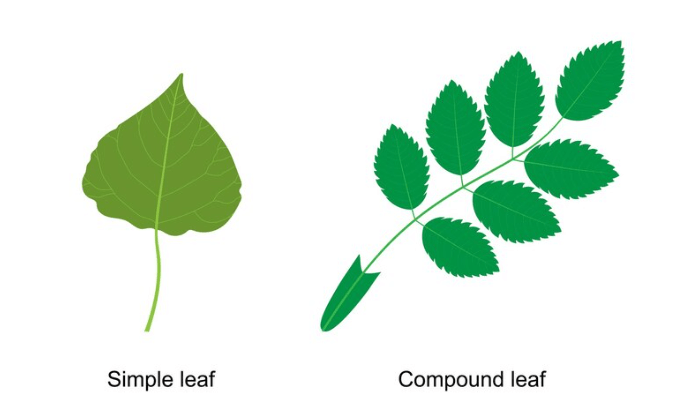
Simple Leaves
Simple leaves are those leaves that are not divided into smaller leaflets. Instead, they consist of a single, undivided blade attached to the stem by a petiole, which is a thin stalk-like structure. Simple leaves come in a variety of shapes, sizes, and textures, depending on the plant species. Some common examples of plants with simple leaves include Oak trees, Maple trees, and Roses. The simple leaves can have different arrangements on the leaf stem, including alternate, opposite, and whorled arrangements. These arrangements refer to how the leaves are positioned in relation to each other along the stem.
Compound Leaves
Compound leaves are another type of leaf structure found in plants. Unlike simple leaves, compound leaves are divided into smaller leaflets, each with its own petiole. This creates the appearance of multiple leaflets emerging from a single leaf stalk, rather than a single, continuous blade. The compound leaves offer several advantages to the plants. It reduces water loss and makes the leaves well-suited to environments with strong winds or arid conditions. There are two main types of compound leaves: Palmately compound leaves and Pinnately compound leaves.
Palmately Compound Leaves
In palmately compound leaves, the leaflets radiate out from a single point at the end of the petiole, resembling the fingers of a hand. Examples of the palmately compound leaves include the leaves of the horse chestnut tree and the clover plant.
Pinnately Compound Leaves
In pinnately compound leaves, the leaflets are arranged along a central stalk, which is known as the Rachis. The arrangement resembles the structure of a feather. Examples of pinnately compound leaves include the leaves of the Ash tree and the Rose tree.

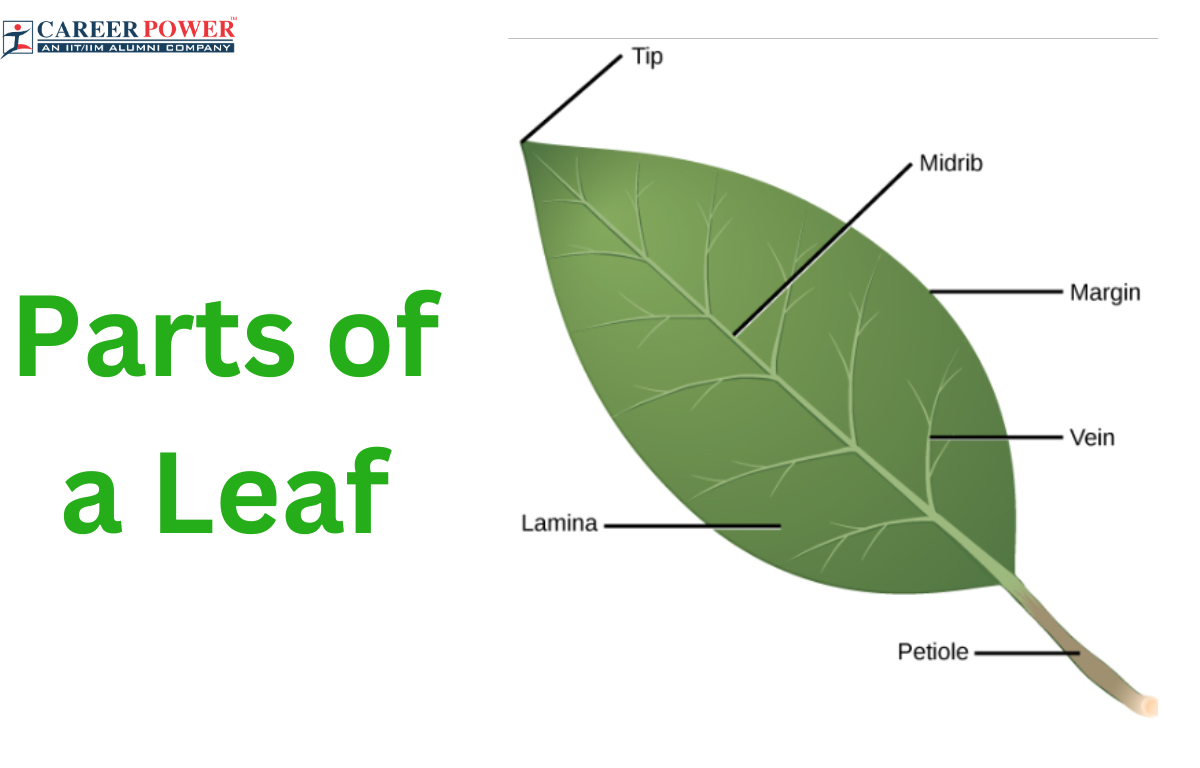

 50 Vegetables Name for Kids in English a...
50 Vegetables Name for Kids in English a...
 Food Chain: Definition, Types, Examples,...
Food Chain: Definition, Types, Examples,...
 Human Respiratory System: Definition, Di...
Human Respiratory System: Definition, Di...













